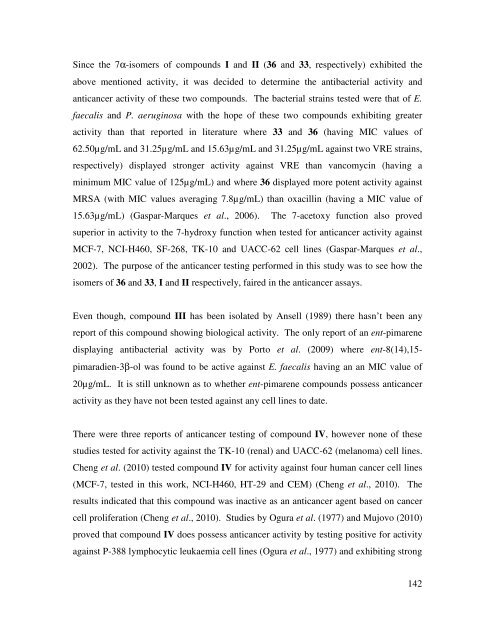university of kwazulu-natal faculty of science and agriculture school ...
university of kwazulu-natal faculty of science and agriculture school ...
university of kwazulu-natal faculty of science and agriculture school ...
Create successful ePaper yourself
Turn your PDF publications into a flip-book with our unique Google optimized e-Paper software.
Since the 7α-isomers <strong>of</strong> compounds I <strong>and</strong> II (36 <strong>and</strong> 33, respectively) exhibited the<br />
above mentioned activity, it was decided to determine the antibacterial activity <strong>and</strong><br />
anticancer activity <strong>of</strong> these two compounds. The bacterial strains tested were that <strong>of</strong> E.<br />
faecalis <strong>and</strong> P. aeruginosa with the hope <strong>of</strong> these two compounds exhibiting greater<br />
activity than that reported in literature where 33 <strong>and</strong> 36 (having MIC values <strong>of</strong><br />
62.50µg/mL <strong>and</strong> 31.25µg/mL <strong>and</strong> 15.63µg/mL <strong>and</strong> 31.25µg/mL against two VRE strains,<br />
respectively) displayed stronger activity against VRE than vancomycin (having a<br />
minimum MIC value <strong>of</strong> 125µg/mL) <strong>and</strong> where 36 displayed more potent activity against<br />
MRSA (with MIC values averaging 7.8µg/mL) than oxacillin (having a MIC value <strong>of</strong><br />
15.63µg/mL) (Gaspar-Marques et al., 2006). The 7-acetoxy function also proved<br />
superior in activity to the 7-hydroxy function when tested for anticancer activity against<br />
MCF-7, NCI-H460, SF-268, TK-10 <strong>and</strong> UACC-62 cell lines (Gaspar-Marques et al.,<br />
2002). The purpose <strong>of</strong> the anticancer testing performed in this study was to see how the<br />
isomers <strong>of</strong> 36 <strong>and</strong> 33, I <strong>and</strong> II respectively, faired in the anticancer assays.<br />
Even though, compound III has been isolated by Ansell (1989) there hasn’t been any<br />
report <strong>of</strong> this compound showing biological activity. The only report <strong>of</strong> an ent-pimarene<br />
displaying antibacterial activity was by Porto et al. (2009) where ent-8(14),15-<br />
pimaradien-3β-ol was found to be active against E. faecalis having an an MIC value <strong>of</strong><br />
20µg/mL. It is still unknown as to whether ent-pimarene compounds possess anticancer<br />
activity as they have not been tested against any cell lines to date.<br />
There were three reports <strong>of</strong> anticancer testing <strong>of</strong> compound IV, however none <strong>of</strong> these<br />
studies tested for activity against the TK-10 (renal) <strong>and</strong> UACC-62 (melanoma) cell lines.<br />
Cheng et al. (2010) tested compound IV for activity against four human cancer cell lines<br />
(MCF-7, tested in this work, NCI-H460, HT-29 <strong>and</strong> CEM) (Cheng et al., 2010). The<br />
results indicated that this compound was inactive as an anticancer agent based on cancer<br />
cell proliferation (Cheng et al., 2010). Studies by Ogura et al. (1977) <strong>and</strong> Mujovo (2010)<br />
proved that compound IV does possess anticancer activity by testing positive for activity<br />
against P-388 lymphocytic leukaemia cell lines (Ogura et al., 1977) <strong>and</strong> exhibiting strong<br />
142

















